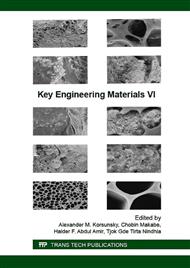p.278
p.283
p.291
p.297
p.304
p.309
p.315
p.323
p.332
Formation of Carbonated Apatite Layer in 1.5× Simulated Body Fluid at Different Refreshing Time
Abstract:
Bioactivity analysis in simulated body fluid (SBF) is an experiment or protocol conducted to evaluate the bioactive properties of a sample without involving cells. The bioactive property is claimed based on the formation of apatite layer after immersion in SBF. This analysis consumes expensive chemical reagents and requires complex procedure in preparing and refreshing the solution. Therefore, the aim of this study was to identify significant alteration of refreshing time in the 1.5× SBF to form an apatite layer on a polydopamine (PDA) grafted stainless steel (SS316L) disk. The SS316L disks were pre-treated and grafted with a PDA layer to equip the bioinert metal surface with a bioactive film. The PDA grafted disks were subjected to bioactivity analysis in SBF for 7 days at different refreshing time (24 h, 48 h, 72 h and not refreshed up to 7 d). The surfaces were then characterised by FTIR, SEM-EDX, and contact angle analyses to determine its chemical composition, morphology and wettability properties. The PDA grafted disks that been subjected to 48 h refreshing time in SBF produced homogenous apatite formation with less agglomeration, closest theoretical Ca/P ratio and high hydrophilicity, suggesting the formation of preferable apatite layer with a reduction in the number of refreshing time.Bioactivity analysis in simulated body fluid (SBF) is an experiment or protocol conducted to evaluate the bioactive properties of a sample without involving cells. The bioactive property is claimed based on the formation of apatite layer after immersion in SBF. This analysis consumes expensive chemical reagents and requires complex procedure in preparing and refreshing the solution. Therefore, the aim of this study was to identify significant alteration of refreshing time in the 1.5× SBF to form an apatite layer on a polydopamine (PDA) grafted stainless steel (SS316L) disk. The SS316L disks were pre-treated and grafted with a PDA layer to equip the bioinert metal surface with a bioactive film. The PDA grafted disks were subjected to bioactivity analysis in SBF for 7 days at different refreshing time (24 h, 48 h, 72 h and not refreshed up to 7 d). The surfaces were then characterised by FTIR, SEM-EDX, and contact angle analyses to determine its chemical composition, morphology and wettability properties. The PDA grafted disks that been subjected to 48 h refreshing time in SBF produced homogenous apatite formation with less agglomeration, closest theoretical Ca/P ratio and high hydrophilicity, suggesting the formation of preferable apatite layer with a reduction in the number of refreshing time.
Info:
Periodical:
Pages:
304-308
Citation:
Online since:
August 2016
Price:
Сopyright:
© 2016 Trans Tech Publications Ltd. All Rights Reserved
Share:
Citation:


